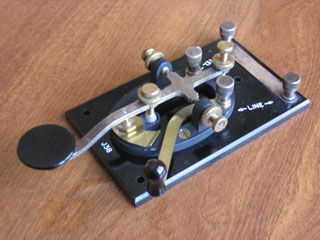To pass the Technician's test, I need to answer 75% of the 35 multiple-choice questions (i.e. 26) correctly. I found 3 sites that had particularly well implemented practice exams (including telling you what you got wrong, and why). Thus unarmed, I took the test cold last night, repeatedly.
The 3 test sites of glory: eHam * RadioExam.org * AA9PW
Taking these cold, I scored in the range of 65-80%. Thus, I'm not afraid of what will happen once I, you know, actually study. I knew a bit of electronics and antenna theory, and there's a huge dose of common sense for a lot of them. In fact, you could probably get 10% just answering anything where you see a choice approximating "because the FCC says so" or "to avoid being electrocuted."
The areas I need work in are primarily jargon-based or in naming specific pieces of gear. The hardest for me? "What is the 'Q' signal used to indicate that you are receiving interference from other stations? QRM, QRN, QTH, QSB?" (answer: well, obviooously QRM... ?)

I do have a barely skimmed copy of Carl Bergquist's "Ham Radio Operator's Guide", from when I first realized HAM was involved in satellite work. Wisdom (if not history) suggests I should read it before the test. Unfortunately, good Carl lists 44 of the 'most commonly used Q-codes'. He's also a talky fellow, which is good for casual reading but frustrating for cramming.
Of more fun, for me, are the answers that can be derived from physics. "Which 23 cm frequency is authorized to a Technician Class operator license? 2315 MHz, 1296 MHz, 3390 MHz, 146.52 MHz?
Okay, wavelength and frequency are inverse, so it's just a question of learning the conversion factor. Formally, the freq (in Hz) = c/wavelength (in m), where c = the speed of light = 3x10^8 m/sec. Instead of converting units, though, I can just remember either that 1 MHz = 300 m, or 100 MHz = 3000 cm, and derive that the freq (in MHz) = 30,000/wavelength (in cm). So the answer is based on 30,000/23, aka 1304. Since authorized spectrum is in wave bands centered on or near the descriptive wavelength, the answer is the value nearest 1304.
In a similar fashion, all the electronics ones work out as Ohm's law-- either V=IR or P=IV. And as mentioned earlier, common sense and an acceptance of person responsibility weigh heavily on the duty and rules sections.
The categories on the test (as per AA9PW) are:
T0: Electrical and RF Safety
T1: FCC Rules, station license responsibilities
T2: Control operator duties
T3: Operating practices
T4: Radio and electronic fundamentals
T5: Station setup and operation
T6: Communications modes and methods
T7: Special operations
T8: Emergency and Public Service Communications
T9: Radio waves, propagation, and antennas
On January 15th, then, I shall be Tested most thoroughly. And upon my expected graduation, I shall be what some call a licensed HAM technician, and what others call a clueless Morse-code-illiterate fancy-pants outsider cluttering their sacred airwaves with my newbie fumbling. To which I reiterate: I am not planning to be a HAM radio user, but my satellite is. And although the test is about using machines and the test is generated by a machine, they still won't grant a license to a machine.
Alex
Launching Project Calliope, sponsored by Science 2.0, in 2011
News every Tuesday at The Satellite Diaries, every Friday at the Daytime Astronomer





Comments